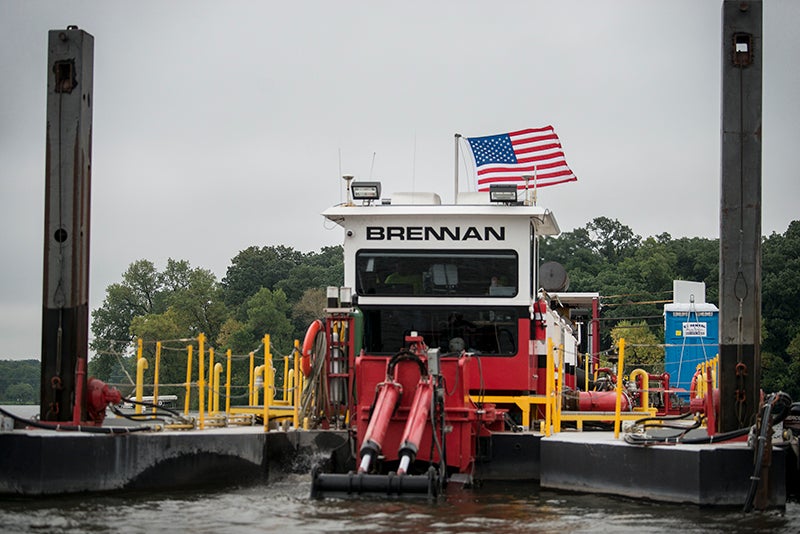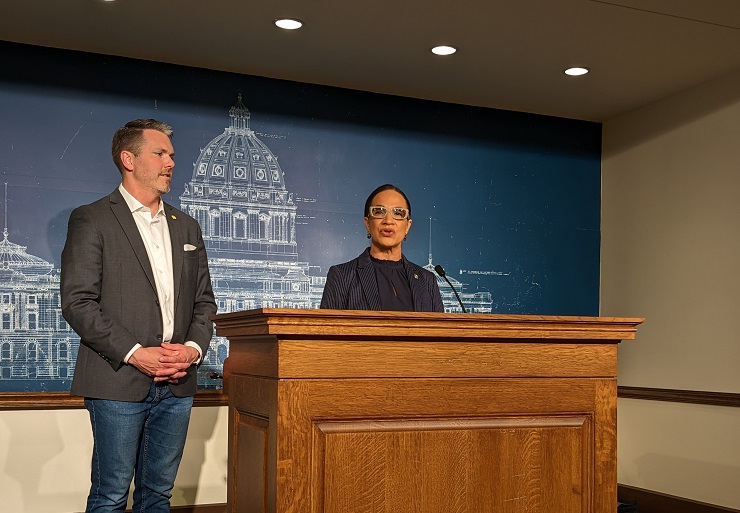Agreement reached on bonding bill; local projects included
Published 7:27 pm Saturday, May 20, 2023

- Dredging started in summer 2018 on Fountain Lake’s Edgewater Bay under the direction of dredging and marine construction company J.F. Brennan. - Colleen Harrison/Albert Lea Tribune
|
Getting your Trinity Audio player ready...
|
Update:
District 23 Sen. Gene Dornink, R-Brownsdale, has confirmed the agreement includes $9 million for the dredging of Fountain Lake and $2 million for the first phase of Albert Lea’s new wastewater treatment plant, along with $14.5 million for Austin’s wastewater treatment facility.
The bill will need to be passed by both the House and Senate and signed off by Gov. Tim Walz before it is official.
Original story:
By Walker Orenstein, Minn Post
Mystical things can happen overnight at the Minnesota Legislature. Between Friday night and Saturday morning, a $1.3 billion cash infrastructure bill suddenly grew into a $2.6 billion cash and bonding plan. And lawmakers now say they’ll dole out an extra $300 million for struggling nursing homes.
All it took was a backroom deal, signed well after midnight, even though House Speaker Melissa Hortman claimed publicly to be moving on from negotiations with minority Republicans over government borrowing for construction projects known as a “bonding bill.”
“It’s over,” Hortman, a DFLer from Brooklyn Park, told reporters last week about talks with the GOP. “We’re done.”
Instead, Minnesota will be getting a last-minute bonding bill because of the deal linked to money for nursing homes. Lawmakers are set to adjourn on Monday.
That means significantly more money will be available for upgrades to things like water treatment plants, college buildings, roads, bridges, parks, trails, police departments, ice arenas and more. The agreement, first reported by MPR News, will also ensure the infrastructure plan is spread more evenly across Minnesota, a change from when DFL lawmakers threatened to pass a bill that tilted heavily towards the Twin Cities metro area.
“We put together a bonding bill and got an agreement that is going to help all Minnesotans and the infrastructure across the state,” said Senate Minority Leader Mark Johnson, R-East Grand Forks, at a news conference Saturday.

How the deal came about
House Republicans agreed to a bonding plan back in March. But Senate Republicans had stalled for months, arguing the DFL should approve more tax cuts before passing an infrastructure plan. Democrats hold narrow majorities in the House and Senate. But that GOP blockade is possible because general obligation bonds need a 60% supermajority, giving Republicans a significant point of leverage to negotiate despite being in the political minority.
The Senate GOP still drew heat from local officials in Greater Minnesota and trade unions who say bonding bills offer critical help for rural areas and high-paying jobs for workers. Especially when Democrats — who did not want to link a bonding bill to their tax plan — promised to use cash from Minnesota’s historically large $17.5 billion surplus to pass a much smaller package of construction projects with less money for rural parts of the state in areas represented by Republicans. Cash only needs a simple majority vote to pass, allowing the DFL to sidestep negotiations with the GOP.
The two sides traded offers for weeks, with Republicans eventually pushing for things like bigger tax rebates. Johnson said they tried “every avenue” to win more money for tax cuts or rebates but kept getting rejected. GOP lawmakers also started asking for more money for nursing homes because they said initial DFL plans were not enough to help a senior care industry in crisis.
But Democrats said last week they were moving on, painting the Senate GOP as recalcitrant in the face of fair offers and hesitant to haggle further while the Legislature approached its May 22 adjournment deadline.
So what changed? Johnson said a final package of human services spending revealed by Democrats this week would leave nursing homes in jeopardy. That pushed them to finally cut a deal. “If we’re going to save one thing, we’ve got to make sure that we save our nursing homes,” Johnson said.
House Minority Leader Lisa Demuth, R-Cold Spring, said there are more than 2,000 empty beds in nursing homes in Minnesota because of staff shortages. “I don’t believe it is enough for nursing home funding, but it’s what was needed” for providers in financial crisis, she said.
The DFL had incentive to strike an agreement, too. Borrowing money for infrastructure through bonding helps lawmakers stretch the cash in their surplus even further. Republicans also agreed to limit debates over budget bills, easing a time crunch for the DFL to meet Monday’s deadline. And Democrats faced criticisms of their own for the geographically lopsided infrastructure proposal.
Hortman noted on Saturday that Minnesota hasn’t passed a bonding bill for nearly three years. That’s a historically long drought, which also increased the DFL’s desire to pass a bonding bill now, expanding the total amount of money Minnesota can spend on infrastructure.
“We’re playing catch-up at this point,” Hortman said, calling the $2.5 billion package “three years of bonding in one.”
Senate Majority Leader Kari Dziedzic, DFL-Minneapolis, said there’s billions of dollars worth of deferred maintenance needs for the Department of Natural Resources alone. “There are needs across the state, and they just keep growing every single year,” she said.
What’s in the deal — that we know of
So what’s in the new $2.6 billion infrastructure package?
Legislative leaders say it will include everything that was in a $1.9 billion infrastructure package approved by the House in March. That bonding plan earned support of some House Republicans before it was rejected in the Senate. And it was considered to be balanced by geography and party.
The new infrastructure proposal will also include everything in the more Twin Cities-centric cash bill Democrats had unveiled. (There is some overlap between the two plans.)
In addition, both parties will get some extra money to pay for new projects. The list of those projects hasn’t been publicly released. Still, Thief River Falls Mayor Brian Holmer said in a written statement that the $2.6 billion plan will serve the needs of Greater Minnesota by funding vital infrastructure for clean drinking water and other essential needs.
Holmer is president of the Coalition of Greater Minnesota Cities, which excoriated Democrats for the cash bill earlier this week because it lacked money for rural areas. The coalition had also criticized Republicans for not agreeing to a bonding deal.
Emily Murray, the transportation and infrastructure policy analyst for the Association of Minnesota Counties, said the DFL’s cash bill had less money for top priorities like roads and bridges, but that will change with a “significant” bonding bill.
“Getting investment in roads and bridges and bus rapid transit, all of that is super important to us,” she said.
Hortman said lawmakers could still use some of their leftover cash for infrastructure next year, along with, potentially, another bonding bill. The two could total $1.6 billion.
The bonding bill is a notable development at the Legislature because Hortman has often refused over the years to give minority Republicans other priorities in exchange for a bonding bill.
But this time, Senate Republicans did secure at least one thing on their wish list. That’s one of few success stories for GOP lawmakers who argue the DFL has steamrolled them all year. And it could provide a blueprint for future political battles over bonding.
“It’s hard to eke out a win,” Johnson said.
— This story was originally published by MinnPost.




